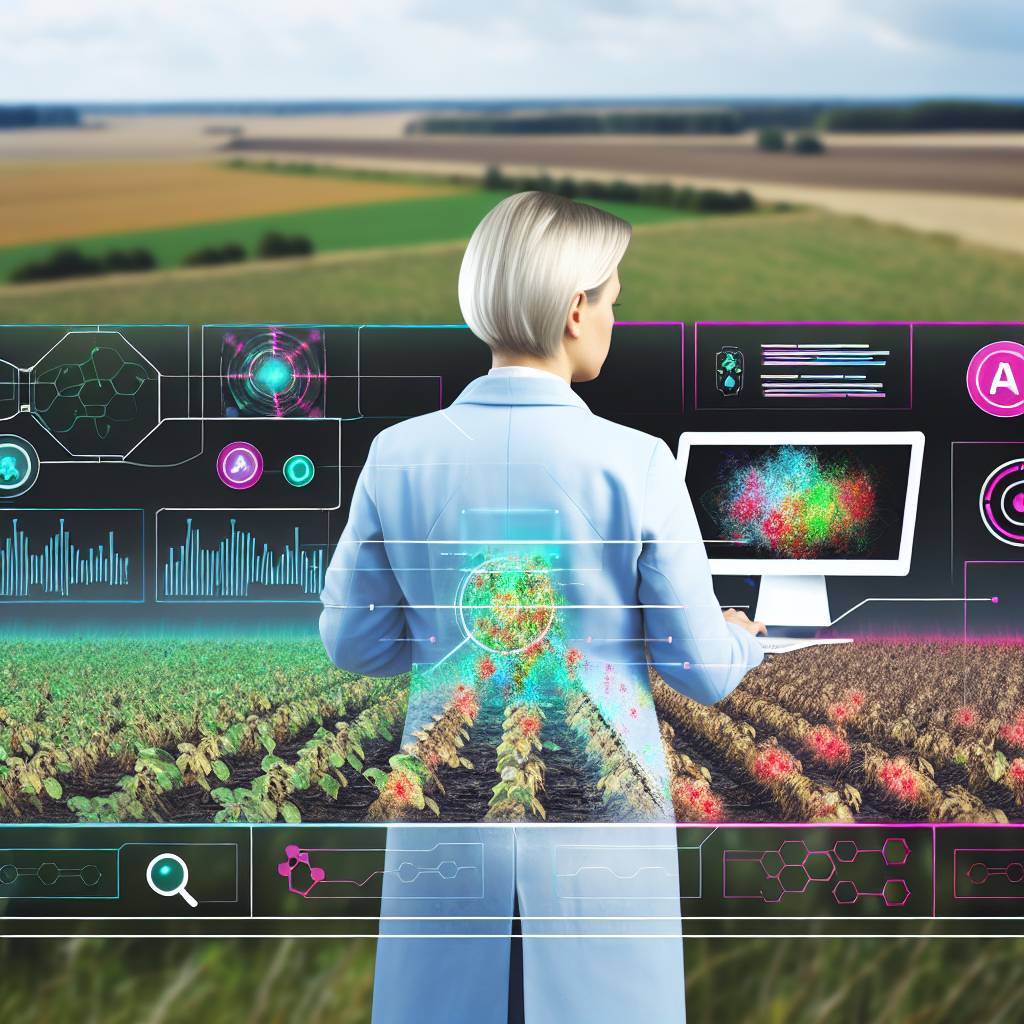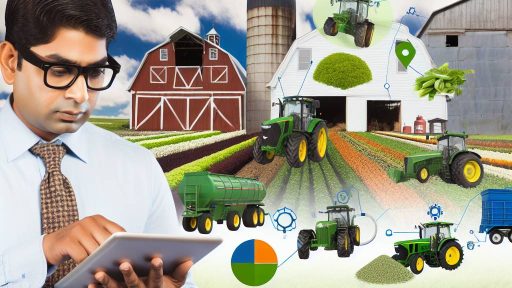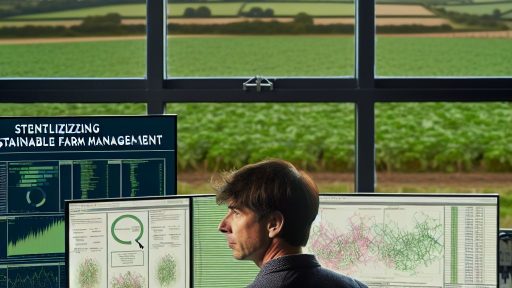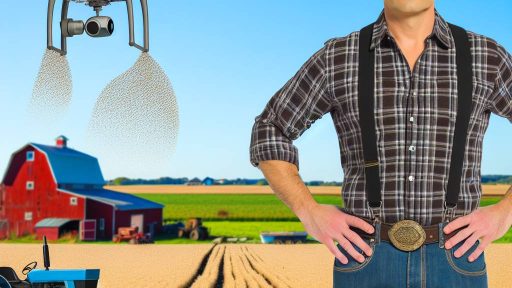Introduction to AI and Machine Learning in Agriculture
Artificial Intelligence (AI) revolutionizes modern agriculture.
It enables farmers to improve crop health and productivity.
Machine Learning (ML) plays a crucial role in this transformation.
Both technologies analyze large sets of data efficiently.
Consequently, they identify patterns that humans might overlook.
The Importance of AI in Agriculture
AI offers numerous benefits for sustainable farming practices.
For instance, it helps optimize resource usage.
This leads to reduced waste and increased efficiency.
Moreover, AI applications assist in predicting agricultural trends.
Farmers can utilize these insights to make informed decisions.
Machine Learning Techniques and Applications
Machine Learning algorithms enable precise crop disease detection.
These algorithms learn from historical data and adapt over time.
As a result, they become more accurate in their predictions.
Common applications include image recognition and data analytics.
This technology allows early intervention for affected crops.
Transform Your Agribusiness
Unlock your farm's potential with expert advice tailored to your needs. Get actionable steps that drive real results.
Get StartedInsights into Crop Disease Detection
AI-driven systems enhance crop disease management strategies.
These systems often utilize drones and satellite imagery.
Consequently, they provide real-time monitoring of plant health.
Farmers can respond promptly to potential threats.
This prevents the spread of diseases, preserving yield quality.
Challenges in Implementing AI Solutions
Despite their potential, AI technologies face various challenges.
Data quality plays a critical role in the effectiveness of AI systems.
Moreover, access to technology can be limited in some regions.
Farmers require training to utilize these sophisticated tools.
Addressing these challenges is vital for broader adoption.
Future Prospects of AI and ML in Agriculture
The future of AI and ML in agriculture appears promising.
Emerging technologies will continue to evolve and improve.
Additionally, collaboration among stakeholders will facilitate innovation.
Investments in research and development are essential for progress.
Ultimately, these advancements will enhance food security globally.
Overview of Crop Diseases and Their Impact on Yield
Understanding Crop Diseases
Crop diseases arise from various pathogens, including fungi, bacteria, and viruses.
These pathogens can severely hinder the growth of plants.
The impact of diseases leads to reduced crop quality and quantity.
Farmers often struggle to manage these challenges effectively.
Types of Crop Diseases
Fungal diseases, such as powdery mildew, are prevalent in many crops.
Bacterial infections can lead to wilting and decay in plants.
Viral diseases often cause stunted growth and yield loss.
Each type of disease requires specific management strategies.
Consequences on Agricultural Yield
Crop diseases significantly reduce agricultural productivity worldwide.
Showcase Your Farming Business
Publish your professional farming services profile on our blog for a one-time fee of $200 and reach a dedicated audience of farmers and agribusiness owners.
Publish Your ProfileThey lead to financial losses for farmers and agricultural businesses.
Declining yields can contribute to food shortages and increased prices.
Ultimately, these diseases threaten food security in many regions.
Importance of Early Detection
Early detection of crop diseases is crucial for effective management.
Timely interventions can minimize crop losses significantly.
Farmers benefit from understanding disease symptoms early on.
Integrating technology can enhance the speed and accuracy of detection.
Role of AI and Machine Learning in Disease Detection
Introduction to AI and Machine Learning
AI and machine learning have revolutionized various fields, including agriculture.
These technologies enable automated systems to analyze extensive datasets effectively.
They significantly enhance the accuracy of detection processes.
Benefits of AI in Crop Disease Detection
AI offers several advantages in identifying crop diseases early.
It can process images and recognize patterns that human eyes might miss.
This ability results in timely interventions, minimizing crop damage.
Moreover, AI systems learn over time, improving their detection capabilities.
Machine Learning Algorithms in Action
Machine learning utilizes algorithms to detect crop diseases efficiently.
Common algorithms include decision trees, support vector machines, and neural networks.
These algorithms analyze diverse data, from soil health to climate conditions.
As a result, they can predict potential disease outbreaks with greater accuracy.
Integration of Data Sources
AI systems thrive on integrated data sources for optimal performance.
Farmers can incorporate satellite imagery, weather data, and sensor inputs.
This diverse data enriches the information available for analysis.
Consequently, it leads to better-informed decisions regarding crop management.
Real-World Applications
Many companies are already implementing AI and machine learning in agriculture.
For instance, companies like AgroAI have developed platforms for disease detection.
These applications utilize smartphone technology for real-time diagnostics.
Farmers gain essential insights to combat crop diseases effectively.
Challenges and Considerations
Despite its advantages, implementing AI poses challenges.
Data quality is critical for the success of machine learning systems.
Additionally, farmers may require training to use these advanced tools.
Ensuring accessibility and usability remains a priority for developers.
You Might Also Like: Cost-Effective Farm Management Software Options For Small Farms
Types of AI Algorithms Used in Crop Disease Detection
Introduction to AI Algorithms
AI algorithms are essential for effective crop disease detection systems.
They analyze vast amounts of data quickly and accurately.
Machine learning is one of the most popular types of AI used in agriculture.
This technology helps in identifying patterns that human eyes may miss.
Supervised Learning
Supervised learning is a common machine learning technique.
This method involves training a model on labeled data.
For instance, researchers can provide images of healthy and diseased plants.
The algorithm learns to differentiate between the two based on features.
Random forests and support vector machines are effective in this area.
Showcase Your Farming Business
Publish your professional farming services profile on our blog for a one-time fee of $200 and reach a dedicated audience of farmers and agribusiness owners.
Publish Your ProfileUnsupervised Learning
Unsupervised learning discovers patterns in unlabeled data.
This approach is beneficial when acquiring labeled data is challenging.
K-means clustering is an example of an unsupervised learning algorithm.
It groups similar data points together without pre-existing labels.
Deep Learning
Deep learning has gained popularity in crop disease detection.
This method uses artificial neural networks to analyze images.
Convolutional neural networks (CNNs) excel at image recognition.
CNNs can identify early signs of diseases in crops effectively.
Image Processing Techniques
Image processing is vital in crop disease detection.
Algorithms enhance and analyze images of crops for disease diagnosis.
Techniques like edge detection and color segmentation are common.
These methods help isolate diseased areas from healthy plant parts.
Decision Trees
Decision trees are simple yet powerful algorithms.
They provide clear decision-making paths based on data features.
This helps in diagnosing crop diseases based on specific symptoms.
Implications of AI Algorithms in Agriculture
Various AI algorithms play crucial roles in agricultural technology.
Each algorithm contributes uniquely to crop disease detection and management.
Uncover the Details: The Future Of Farming Trends In Automated Machinery
Data Collection Methods for Training AI Models
Importance of Data Quality
High-quality data is crucial for effective AI models.
It enhances accuracy and reduces errors in predictions.
Moreover, poor data quality can lead to unreliable results.
Types of Data Sources
Various data sources contribute to crop disease detection.
Images play a significant role in identifying symptoms.
Additionally, sensor data provides insights into environmental conditions.
Field reports can also help identify disease outbreaks early.
Image Data Collection
Collecting images requires careful planning.
Farmers can use smartphones to capture plant images.
These images should show both healthy and diseased plants.
Using consistent lighting and angles improves data quality.
Sensor Data Gathering
Sensors measure environmental factors affecting crop health.
Parameters like humidity, temperature, and soil moisture are vital.
Placing sensors strategically increases data accuracy and coverage.
Data Annotation for AI Training
Data annotation is essential for training AI models.
This process involves labeling images and sensor data accurately.
Experts can categorize diseases based on collected data.
Tools and software can facilitate effective annotation.
Integration of Multiple Data Sources
Integrating diverse data sources strengthens AI models.
This approach allows for comprehensive disease detection.
By combining images and sensor data, insights are enhanced.
Furthermore, data integration improves decision-making processes.
Showcase Your Farming Business
Publish your professional farming services profile on our blog for a one-time fee of $200 and reach a dedicated audience of farmers and agribusiness owners.
Publish Your ProfileEthical Considerations in Data Collection
Ensuring ethical practices in data collection is paramount.
Farmers’ privacy and consent must be respected at all times.
Transparency in data usage builds trust within communities.
Responsible data management promotes sustainable practices.
Delve into the Subject: Greenhouse Technologies Advancing Sustainable Agricultural Methods
Integration of IoT Devices for Real-time Monitoring
Overview of IoT in Agriculture
IoT devices revolutionize agricultural practices today.
They enable farmers to monitor crops consistently and accurately.
These devices collect vital data in real-time.
Consequently, farmers make informed decisions swiftly.
Types of IoT Devices
Various IoT devices enhance crop monitoring efforts.
- Soil moisture sensors provide crucial irrigation data.
- Weather stations offer localized climate information.
- Drones capture aerial images for health assessments.
Additionally, video cameras enable continuous surveillance.
Data Analysis and Machine Learning
Data collected by IoT devices needs analysis for effective use.
Machine learning algorithms process vast amounts of data efficiently.
They detect patterns that indicate potential crop diseases.
Moreover, timely alerts help prevent widespread damage.
Benefits of Real-time Monitoring
Implementing IoT enhances agricultural efficiency significantly.
It allows for precise resource allocation, reducing waste.
Furthermore, it helps in optimizing crop yields.
Farmers gain the ability to respond promptly to emerging threats.
Challenges in Implementation
Despite the benefits, challenges exist in adopting IoT technology.
Initial costs can be high for small-scale farmers.
Moreover, technical know-how is necessary for effective usage.
Lastly, data security and privacy remain critical concerns.
Learn More: Genetically Modified Crops: Myths Vs. Facts For Farmers

Case Studies: Successful Implementations in Various Crops
Cassava Disease Detection
Cassava is a vital food source for millions globally.
In Nigeria, farmers faced widespread cassava mosaic disease.
The Irina Agricultural Institute developed an AI solution.
This system uses image recognition to identify infected plants.
Farmers reported a 30% increase in yield after using the system.
Rice Crop Monitoring
Rice is a staple food for over half of the world’s population.
In Vietnam, the Agricultural Science Institute implemented AI tools.
The system effectively monitors pest behaviors and disease outbreaks.
Data collection through drones enhances monitoring efficiency.
Consequently, rice farmers improved their crop health significantly.
Tomato Blight Management
Tomato crops are susceptible to various diseases, including blight.
In California, local growers adopted machine learning models.
These models analyze weather patterns and soil health data.
The result was early detection of potential blight conditions.
Growers noted a major reduction in loss rates due to timely interventions.
Wheat Disease Prevention
Wheat is essential for food security worldwide.
Showcase Your Farming Business
Publish your professional farming services profile on our blog for a one-time fee of $200 and reach a dedicated audience of farmers and agribusiness owners.
Publish Your ProfileIn India, the Central Research Institute initiated an AI project.
This project utilizes satellite images for disease monitoring.
Moreover, it predicts disease risks based on historical data.
As a result, wheat farmers experienced a boost in overall productivity.
Fruit Orchard Health Analytics
Fruit orchards often face challenges from diseases like apple scab.
In Australia, a tech startup launched a mobile application.
This app combines weather forecasts with disease prediction algorithms.
Farmers received timely alerts to protect their orchards effectively.
Overall, they observed healthier fruits and increased sales revenue.
Challenges and Limitations of AI in Crop Disease Detection
Data Quality and Availability
Data quality plays a crucial role in AI effectiveness.
Inaccurate or incomplete data hinders reliable predictions.
Furthermore, obtaining high-quality images of crops is challenging.
Farmers often lack access to sufficient data for training AI models.
Technical Complexity
Implementing AI systems requires specialized knowledge.
Many farmers lack the technical skills to operate these technologies.
Moreover, integrating AI with existing farming practices is complex.
High Initial Costs
The costs associated with AI technology can be prohibitive.
Smallholder farmers may struggle to afford these investments.
Access to funding and financial support is often limited.
Regulatory and Ethical Concerns
AI in crop disease detection raises ethical questions.
Privacy concerns about data usage can deter adoption.
Moreover, regulatory frameworks for AI applications are still evolving.
Dependence on Technology
Over-reliance on AI may lead to decreased traditional skills.
Farmers might depend too heavily on technology for decision-making.
Consequently, a lack of human oversight could be problematic.
Environmental Variability
Crop diseases can manifest differently across regions.
AI models may struggle with this variability in environmental conditions.
This limitation might affect the accuracy of disease detection.
Future Trends in AI and Machine Learning for Agriculture
Integration of Advanced Technologies
Farmers increasingly integrate AI tools into their operations.
This integration enhances decision-making and improves resource management.
Furthermore, the use of drones and sensors streamlines data collection.
These technologies provide real-time insights to optimize crop production.
Precision Agriculture
Precision agriculture will continue to evolve with machine learning advancements.
This method uses data analytics to fine-tune planting strategies.
Moreover, it enables targeted application of fertilizers and pesticides.
As a result, environmental impacts decrease significantly.
Development of Predictive Models
AI-driven predictive models are becoming more sophisticated.
These models forecast pest outbreaks and disease spread effectively.
Farmers can prepare for potential crop threats in advance.
Consequently, proactive measures reduce crop losses significantly.
Showcase Your Farming Business
Publish your professional farming services profile on our blog for a one-time fee of $200 and reach a dedicated audience of farmers and agribusiness owners.
Publish Your ProfileData-Driven Decision Making
Data analytics will play a crucial role in future agriculture trends.
Farmers will rely more on data to make informed decisions.
This shift will lead to enhanced crop yields and efficiency.
Additionally, accessing integrated platforms will be more common.
Collaboration with Tech Companies
Agricultural producers will increasingly partner with technology firms.
These collaborations will foster innovations tailored to farming needs.
For instance, startups are developing tailored AI solutions for farmers.
Ultimately, these efforts will drive technological advancements in the industry.
Focus on Sustainability
There will be a growing emphasis on sustainable farming practices.
Machine learning will help develop environmentally friendly solutions.
Farmers will use AI to minimize the use of chemical inputs.
This transition supports both the ecosystem and agricultural viability.
Additional Resources
S1090: AI in Agroecosystems: Big Data and Smart Technology …




